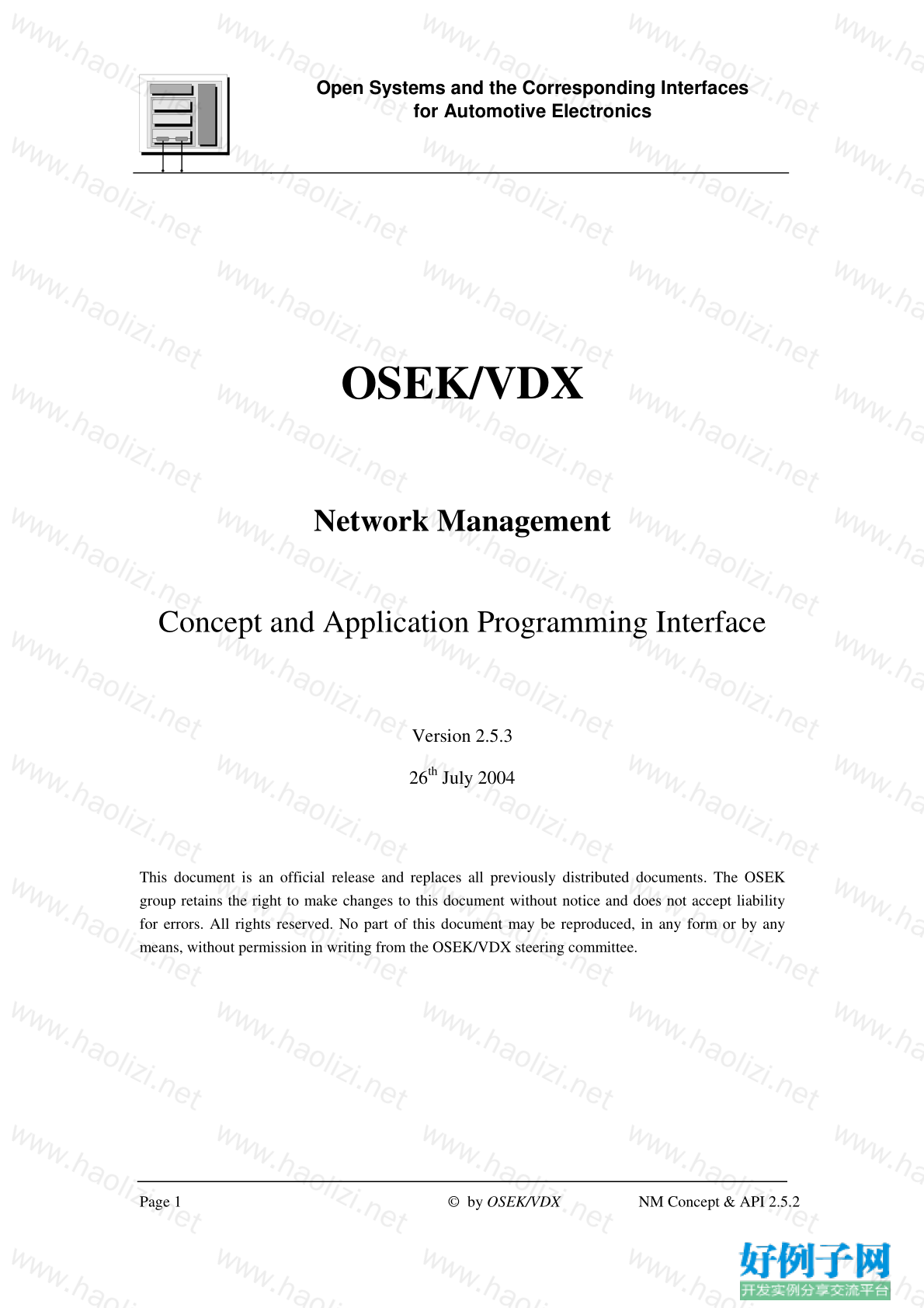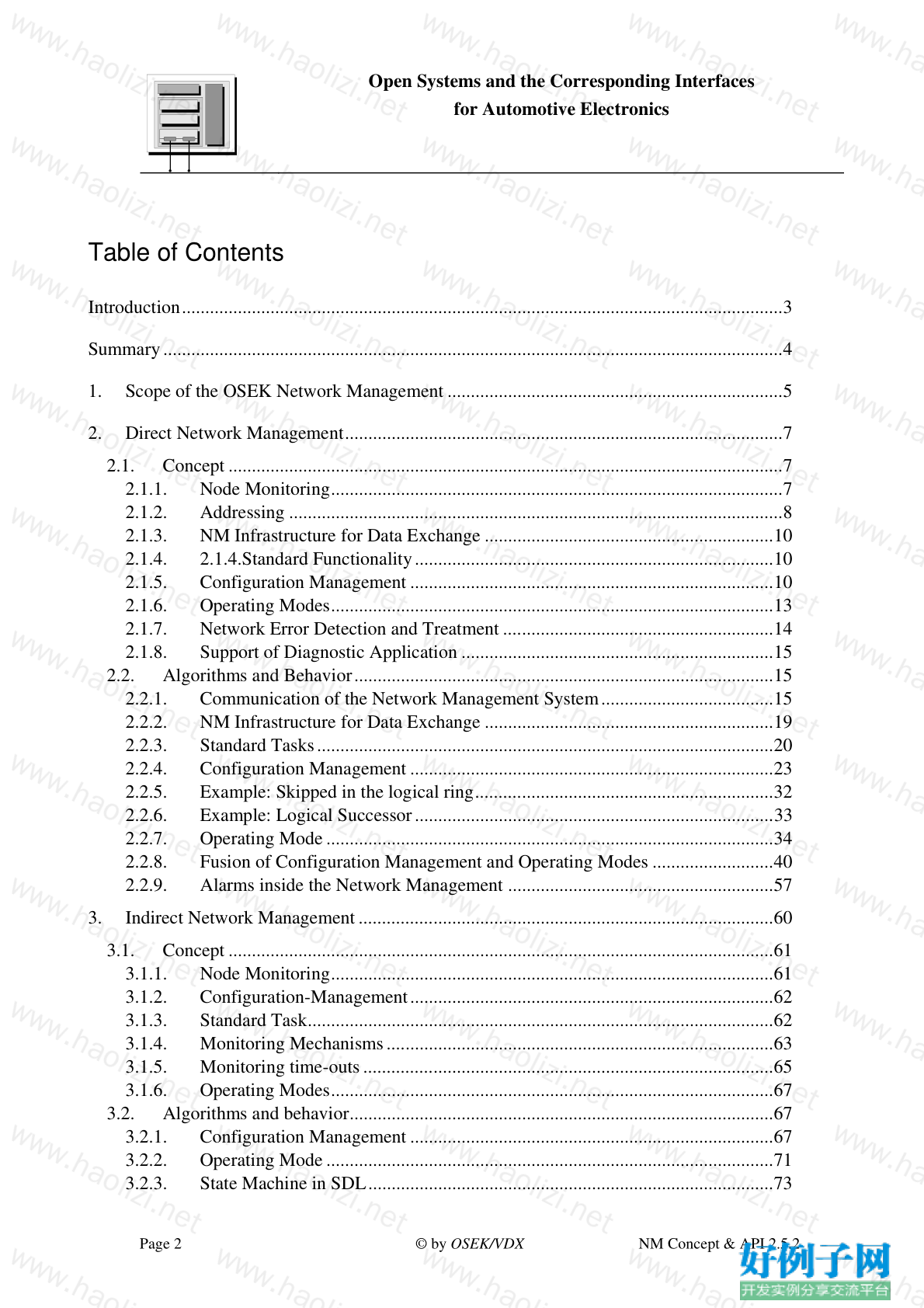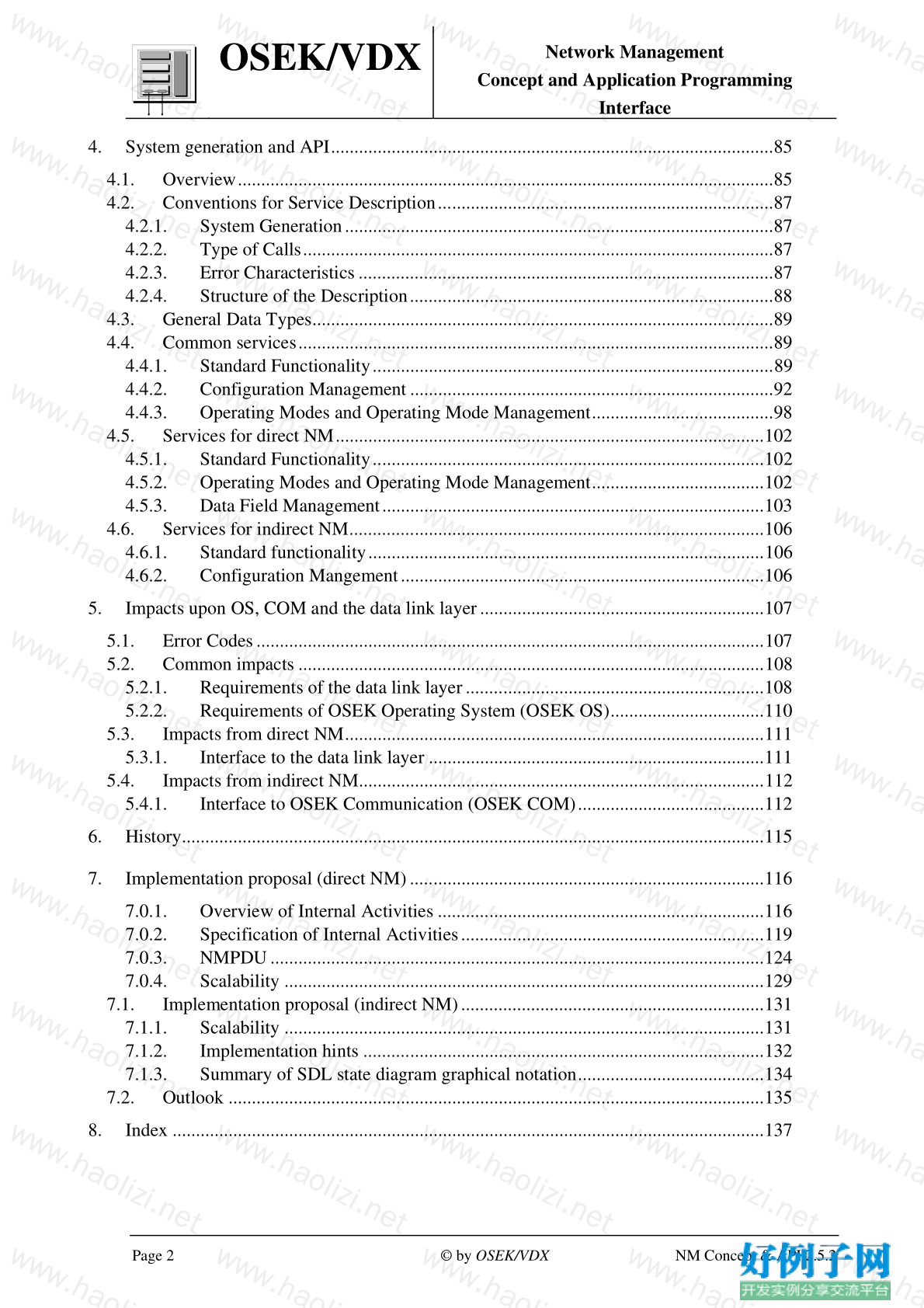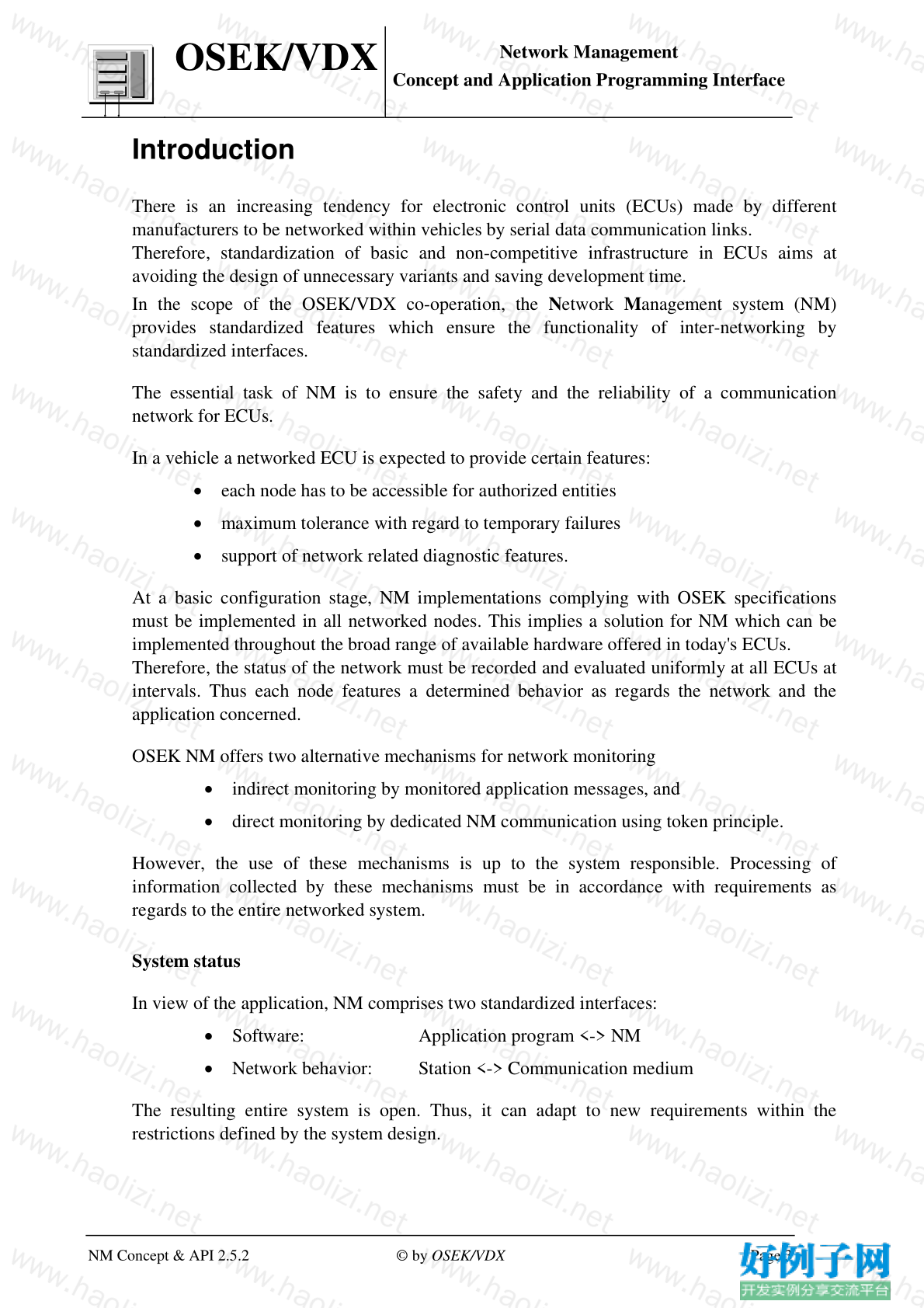实例介绍
【实例截图】





【核心代码】
Table of Contents
Introduction.................................................................................................................................3
Summary.....................................................................................................................................4
1. Scope of the OSEK Network Management ........................................................................5
2. Direct Network Management..............................................................................................7
2.1. Concept.......................................................................................................................7
2.1.1. Node Monitoring.................................................................................................7
2.1.2. Addressing ..........................................................................................................8
2.1.3. NM Infrastructure for Data Exchange ..............................................................10
2.1.4. 2.1.4.Standard Functionality.............................................................................10
2.1.5. Configuration Management..............................................................................10
2.1.6. Operating Modes...............................................................................................13
2.1.7. Network Error Detection and Treatment ..........................................................14
2.1.8. Support of Diagnostic Application ...................................................................15
2.2. Algorithms and Behavior..........................................................................................15
2.2.1. Communication of the Network Management System.....................................15
2.2.2. NM Infrastructure for Data Exchange ..............................................................19
2.2.3. Standard Tasks..................................................................................................20
2.2.4. Configuration Management..............................................................................23
2.2.5. Example: Skipped in the logical ring................................................................32
2.2.6. Example: Logical Successor.............................................................................33
2.2.7. Operating Mode................................................................................................34
2.2.8. Fusion of Configuration Management and Operating Modes ..........................40
2.2.9. Alarms inside the Network Management .........................................................57
3. Indirect Network Management.........................................................................................60
3.1. Concept.....................................................................................................................61
3.1.1. Node Monitoring...............................................................................................61
3.1.2. Configuration-Management..............................................................................62
3.1.3. Standard Task....................................................................................................62
3.1.4. Monitoring Mechanisms...................................................................................63
3.1.5. Monitoring time-outs........................................................................................65
3.1.6. Operating Modes...............................................................................................67
3.2. Algorithms and behavior...........................................................................................67
3.2.1. Configuration Management..............................................................................67
3.2.2. Operating Mode................................................................................................71
3.2.3. State Machine in SDL.......................................................................................73
OSEK/VDX
OSEK/VDX
Network Management
Concept and Application Programming
Interface
Page 2 © by OSEK/VDX NM Concept & API 2.5.2
4. System generation and API...............................................................................................85
4.1. Overview...................................................................................................................85
4.2. Conventions for Service Description........................................................................87
4.2.1. System Generation............................................................................................87
4.2.2. Type of Calls.....................................................................................................87
4.2.3. Error Characteristics .........................................................................................87
4.2.4. Structure of the Description..............................................................................88
4.3. General Data Types...................................................................................................89
4.4. Common services......................................................................................................89
4.4.1. Standard Functionality......................................................................................89
4.4.2. Configuration Management..............................................................................92
4.4.3. Operating Modes and Operating Mode Management.......................................98
4.5. Services for direct NM............................................................................................102
4.5.1. Standard Functionality....................................................................................102
4.5.2. Operating Modes and Operating Mode Management.....................................102
4.5.3. Data Field Management..................................................................................103
4.6. Services for indirect NM.........................................................................................106
4.6.1. Standard functionality.....................................................................................106
4.6.2. Configuration Mangement..............................................................................106
5. Impacts upon OS, COM and the data link layer.............................................................107
5.1. Error Codes.............................................................................................................107
5.2. Common impacts ....................................................................................................108
5.2.1. Requirements of the data link layer................................................................108
5.2.2. Requirements of OSEK Operating System (OSEK OS).................................110
5.3. Impacts from direct NM..........................................................................................111
5.3.1. Interface to the data link layer ........................................................................111
5.4. Impacts from indirect NM.......................................................................................112
5.4.1. Interface to OSEK Communication (OSEK COM)........................................112
6. History.............................................................................................................................115
7. Implementation proposal (direct NM)............................................................................116
7.0.1. Overview of Internal Activities ......................................................................116
7.0.2. Specification of Internal Activities.................................................................119
7.0.3. NMPDU..........................................................................................................124
7.0.4. Scalability .......................................................................................................129
7.1. Implementation proposal (indirect NM).................................................................131
7.1.1. Scalability .......................................................................................................131
7.1.2. Implementation hints ......................................................................................132
7.1.3. Summary of SDL state diagram graphical notation........................................134
7.2. Outlook ...................................................................................................................135
8. Index ...............................................................................................................................137
小贴士
感谢您为本站写下的评论,您的评论对其它用户来说具有重要的参考价值,所以请认真填写。
- 类似“顶”、“沙发”之类没有营养的文字,对勤劳贡献的楼主来说是令人沮丧的反馈信息。
- 相信您也不想看到一排文字/表情墙,所以请不要反馈意义不大的重复字符,也请尽量不要纯表情的回复。
- 提问之前请再仔细看一遍楼主的说明,或许是您遗漏了。
- 请勿到处挖坑绊人、招贴广告。既占空间让人厌烦,又没人会搭理,于人于己都无利。
关于好例子网
本站旨在为广大IT学习爱好者提供一个非营利性互相学习交流分享平台。本站所有资源都可以被免费获取学习研究。本站资源来自网友分享,对搜索内容的合法性不具有预见性、识别性、控制性,仅供学习研究,请务必在下载后24小时内给予删除,不得用于其他任何用途,否则后果自负。基于互联网的特殊性,平台无法对用户传输的作品、信息、内容的权属或合法性、安全性、合规性、真实性、科学性、完整权、有效性等进行实质审查;无论平台是否已进行审查,用户均应自行承担因其传输的作品、信息、内容而可能或已经产生的侵权或权属纠纷等法律责任。本站所有资源不代表本站的观点或立场,基于网友分享,根据中国法律《信息网络传播权保护条例》第二十二与二十三条之规定,若资源存在侵权或相关问题请联系本站客服人员,点此联系我们。关于更多版权及免责申明参见 版权及免责申明



网友评论
我要评论